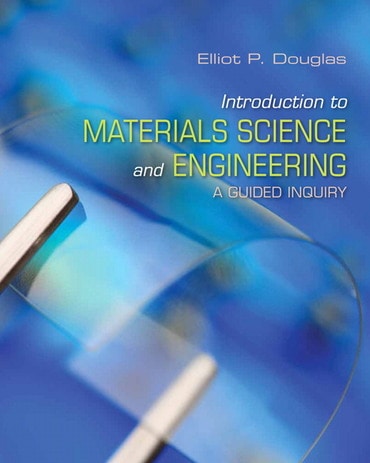
Title overview
For the Introductory Materials Science course.¿Learn about Guided Inquiry Implementation in Materials Science here: http://www.pearsonhighered.com/douglas1einfo
¿
This unique textbook is designed to serve as an active learning tool that uses carefully selected information and guided inquiry questions. Guided inquiry helps students reach true understanding of concepts as they develop greater ownership over the material presented. First, background information or data is presented. Then, concept invention questions lead the students to construct their own understanding of the fundamental concepts represented. Finally, application questions provide the students with practice in solving problems using the concepts that they have derived from their own valid conclusions.¿
Learn more about Guided Inquiry Implementation in Materials Science here: http://www.pearsonhighered.com/douglas1einfo
- An active learning tool with carefully selected information. You’ll notice this textbook is slimmer than your average textbook. Students do not need to be told every detail about every topic, but they do need to learn the fundamental concepts. The focus of this book is on enabling students to actively engage in the content, struggle with the concepts, and ultimately discover those concepts for themselves.
- Guided inquiry helps students use their own valid conclusions to understand concepts–as opposed to having it simply told to them. This book can be used in many ways, but was written based on the approach of Process-Oriented Guided Inquiry Learning™ (POGIL), where students work in small groups on specially designed guided inquiry questions. To make sure that students understand the important concepts, they are guided through the information by answering 3 types of specific guided inquiry questions:
- Exploration questions ask students to find information that is already presented in the text, or that they can answer from common knowledge.
- Concept Invention questions ask students to use the answers from the exploration questions to figure out a general concept or approach to solving a problem. These are the key questions of every chapter, because this is where the discovery occurs.
- Application questions help students practice using the concepts. The problems are divided into two categories, skill problems and conceptual problems. Skill problems are very similar to the example problems in the chapter. Conceptual problems ask students to think a bit beyond the example problems. They are still based on the same concepts, but they apply those concepts in different ways from what students have seen in the chapters.
- Additional features will help students master the material.
- Concept Checks test students’ understanding of key points. Answers to the Concept Checks are in the back of the book.
- Example Problems help students understand how to apply the concepts. Some of the example problems include hints that will help when they have to solve similar problems.
- Application Spotlights show how some of the concepts and ideas are actually used in engineering, with an emphasis on issues related to the environment.
- MasteringEngineering, the most technologically advanced online tutorial and homework system available, can be packaged with this edition.¿MasteringEngineering is designed to provide students with customized coaching and individualized feedback to help improve problem-solving skills while providing instructors with rich teaching diagnostics.
Table of contents
Preface
Part I: Introduction
Chapter 1: What is Guided Inquiry?
1.1 First Law of Thermodynamics
1.2 Active Learning
Chapter 2: What is Materials Science and Engineering?
2.1 Types of Materials
2.2 The MSE Triangle
Part II: Atomic and Molecular Structure of Materials
Chapter 3: Bonding
3.1 Electronegativity
3.2 Primary Bonds
3.3 Non-Bonding Interactions
Chapter 4: Atomic Arrangements in Solids
4.1 Crystalline and Amorphous Materials
4.2 Unit Cells
4.3 Miller Indices
4.4 Planes and Directions in Crystals
4.5 Crystalline Defects
4.6 Ceramic Crystal Structures
4.7 Defects in Ceramic Crystals
4.8 Determining Crystal Structure: Diffraction
Chapter 5: The Structure of Polymers
5.1 Molecular Structure
5.2 Molecular Weight
5.3 Polymer Crystals
5.4 The Glass Transition
Chapter 6: Microstructure: Phase Diagrams
6.1 Defining Mixtures
6.2 Isomorphous Binary Phase Diagrams – The Lever Rule
6.3 Isomorphous Binary Phase Diagrams – Microstructure
6.4 Eutectic Phase Diagrams – Microstructure
6.5 Eutectic Phase Diagrams – Microconstituents
6.6 Peritectic Phase Diagrams
6.7 Intermetallic and Ceramic Phase Diagrams
Chapter 7: Diffusion
7.1 Diffusion Mechanisms
7.2 Diffusion Calculations: Fick’s Laws
Chapter 8: Microstructure: Kinetics
8.1 Nucleation and Growth
8.2 Heterogeneous Nucleation
8.3 Equilibrium vs. Nonequilibrium Cooling
8.4 Isothermal Transformation Diagrams
8.5 Continuous Cooling Transformation Diagrams
Part III: Properties and Uses of Materials
Chapter 9: Mechanical Behavior
9.1 Stress-Strain Curves
9.2 Bond-Force and Bond-Energy Curves
9.3 Strength of Metals
9.4 Strengthening Mechanisms for Metals
9.5 Structure-Property-Processing Relationships in Steel
9.6 Polymer Properties
9.7 Properties of Ceramics
9.8 Fracture
9.9 Fatigue
9.10 Hardness
9.11 Viscoelasticity
9.12 Composites
Chapter 10: Materials in the Environment
10.1 Electrochemistry: How Does a Battery Work?
10.2 Corrosion of Metals
10.3 Oxide Formation
10.4 Degradation of Polymers
Chapter 11: Electronic Behavior
11.1 Band Structure of Materials
11.2 Electronic Properties
11.3 Conductors
11.4 Semiconductors
11.5 Solid-State Devices
Chapter 12: Thermal Behavior
12.1 Heat Capacity
12.2 Thermal Expansion
12.3 Thermal Conductivity
Chapter 13: Materials Selection and Design
13.1 Ranking Procedures
13.2 Ashby Plots